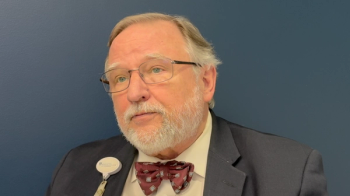
How Will RLTs Be Integrated Into the Prostate Cancer Treatment Paradigm?
RLT-based combinations, RLTs across genitourinary cancers, and RLTs in earlier lines of therapy are among the considerations for further research.
Despite radioligand therapy (RLT) only being
Specifically for prostate cancer, Ravi highlighted ongoing research evaluating earlier lines of RLTs and use without hormone therapy in oligometastatic disease. He further touched upon future research considerations for RLT use, covering their use in combination therapies as well as across a variety of cancers, GU and non-GU alike.
“[GU cancer] is like a shining light for RLT in solid tumors. It is already in and will extend to other solid tumors soon, even looking at pan-tumor targets like fibroblast activation protein,” Ravi concluded. “We are at the early phase of this RLT era, and there are plenty of things to come.”
CancerNetwork: What are the key indications for using RLT in genitourinary cancers, and how does the treatment selection differ based on the type of disease?
Ravi: Right now, the only indication for using RLT is in prostate cancer: PSMA, which stands for prostate-specific membrane antigen. PSA-targeted RLT with lutetium 177 [Pluvicto] is currently the only approved RLT in GU cancer. Right now, it has been approved in the postchemotherapy and the prechemotherapy castration-resistant prostate cancer setting. That label was extended to the prechemotherapy setting recently, so it is the metastatic CRPC pre- and postchemotherapy setting that is the only approved indication for lutetium-177-PSMA.
How do you integrate RLT into the treatment paradigm for patients with metastatic prostate cancer, and is there a place for it within combination therapies?
I view RLT as a chess piece on the chessboard. I tell patients for prostate cancer, we have 3 therapy buckets. We have the hormonal agents, androgen receptor pathway inhibitors [ARPIs]. We have taxanes––chemotherapy––and then we have the RLTs. We think about what the right time is to use each one. Right now, in the hormone-sensitive setting, there is no approved indication for RLT. That space is androgen deprivation therapy [ADT] plus ARPI or ADT plus ARPI plus chemotherapy doublet or triplet approach, and generally, in that progression after first-line therapy for hormone-sensitive diseases is when I start thinking about RLT. I use features such as the extent of avid disease, whether the patient is symptomatic or not, how high the expression is, how intense the target is. Those types of features decide now is the right time post ARPI or post triplet to use RLT vs another agent or think about a clinical trial in terms of combinations.
The way RLT––lutetium-177-PSMA-617, at least––was studied, it was done in the [phase 3] VISION trial [NCT03511664] either alone or patients could be on an ARPI with it, and in PSMA4, it was done alone.2 Generally speaking, we tend to prescribe it alone, but there are increasing data that adding it in combination with an ARPI might improve the outcomes further. There are some weak data that an ARPI might upregulate PSMA expression and therefore enhance the response to PSMA-targeted therapy, or PSMA RLT. This was seen in the [phase 2] ENZA-p study [NCT04419402].3 There is also a post hoc analysis from the VISION trial showing that patients who had a concurrent ARPI with lutetium 177 did slightly better than those who did not.
In general, if I have a patient who is on an ARPI already and I am thinking about moving to lutetium 177, I think about continuing that just in case it might improve the outcomes if it is not causing extra [adverse] effects [or] financially toxic to the patient. We start thinking about combinations. There is increasing interest and study of combinations with RLT, ongoing clinical trials, including things that we are doing at our own institution, to look at this, to see how we can optimize lutetium-177-PSMA-617 RLT even further.
How is a patient's response to RLT monitored, and what are the key imaging and biochemical markers you use to assess treatment efficacy?
Typically, all patients get a PSA [test]. PSA is one of the most common biomarkers we use across the prostate cancer disease spectrum [and] certainly in [patients receiving] radioligands. PSA is generally a good marker of early decline by week 12, within 2 cycles, if lutetium 177 is prognostic. We know that from the analysis of [the phase 3 VISION trial] as well as other work that has been included by ourselves. PSA is generally a good biomarker.
Scans are also integral. Every patient does have a PSMA-PET [scan] done prior to starting RLT, so that is already there at baseline. I personally repeat imaging during therapy, at least after 2 or 3 cycles, whether that is with the PSMA-PET, if they have had one at baseline—which they have—or with CT and bone scan, which they might also have had. I generally advocate for imaging. The reason is that there are patients who may have radiographic progression in the absence of PSA progression. We know that from other agents and other trials and the work that we have looked at as well. That is to capture that small number of patients who may have progression despite PSA decline.
There is also increasing use of SPECT [single-photon emission CT]…and I am not a nuclear medicine physician, but I like it as a poor man’s PET. It can be done quickly. It can be done within 4 to 24 hours after the dose of lutetium 177 is given, and that images uptake of the drug into the organs. Some institutions do this at every cycle. At Dana-Farber, we do it at cycle 1 and at cycle 3. If I have a reassuring SPECT [scan] and a reassuring PSA decline and no clinical concerns, I do not necessarily gather further imaging beyond that. Sometimes we do. There are no clear-cut guidelines on this.
The Prostate Cancer Working Group [PCWG] 3, NCCN, and American Society of Clinical Oncology advocate for some imaging, typically with CT bone scans.4-6 If a patient has had a PET scan, why do they also need a CT bone scan to follow? It just seems a bit redundant. There are new imaging guidelines upcoming through the PCWG, so we will see what those say. Generally, it is a mix of PSA plus some imaging, whether that is SPECT, PET, or CT bone scan.
What are the most significant challenges in the widespread adoption of RLT, and how can they be addressed in a community oncology setting?
I work in an academic center where we have excellent relationships/infrastructure with nuclear medicine. At our institution, nuclear medicine [physicians] are the deliverers of this therapy [to] medical oncology. Nuclear medicine [physicians] work in a close partnership [with] medical oncology. We see the patients, we refer them to nuclear medicine to do the treatment, and we comanage them. It is not like other therapies, where it is available off the shelf. There is much complex coordination involved with ordering the dose [and] coordinating the radiation safety; the people who deliver it must have radiation safety credentialing and licensing. These are barriers to adopting this in the community.
I have seen, however, in the last couple of years, it has become increasingly available in the community. I know when this treatment was approved in 2022, patients in New England were traveling to Boston—Dana-Farber—to get [RLT], because it was the only real place where it could be received. Now it is becoming increasingly available in other smaller communities or bigger community clinics. You do not have to travel [as] far to get it. There are unique challenges to this, as opposed to other drugs.
Generally, medical oncologists do not prescribe this because we do not have the credentialing for radiation precautions. It must be done in conjunction with either nuclear medicine or radiation oncology sometimes, and you need to have that multidisciplinary collaboration to do this. Also, in terms of logistics to get the dose ordered, have the treatment ready [and] the treatment rooms ready, there are more resources needed to ensure that it all goes smoothly for the patient.
How do you manage common adverse effects associated with RLT?
Particularly with lutetium-177-PSMA-617 and the small-molecule PSMA ligands, it is generally well tolerated. The toxicities are similar to chemotherapy but generally a magnitude of [grade] 2 or lower; the fatigue and the myelosuppression are generally not as bad as with chemotherapy. We tell patients we monitor the blood counts carefully during treatment. Often, when we start, we do [blood count tests] every 3 weeks to make sure [they are not] dipping.
Fatigue is a hard one to manage. There are no great medications or treatments. Things like staying active—exercise can help. In terms of the unique toxicities, dry mouth is one. That is because PSMA is expressed in the salivary glands, so trying to [keep patients] as hydrated as possible, keep the mouth and the oral mucosa moist [and] hydrating well. Those are important to help. Sometimes, if the toxicities, especially the dry mouth, become significant and interfere with oral intake and cause weight loss, then we must think about [reducing the] dose or stopping treatment.
Some of the longer-term [adverse] effects are becoming increasingly recognized with RLT: things like renal damage, renal toxicity, and potentially bone marrow toxicity. We are starting to recognize these as patients are starting to live longer and as these treatments get moved earlier in the disease course, and that is going to require more thought and care about how we consider those toxicities as we move these agents earlier, as it will be inevitable.
What ongoing research or clinical trials in RLT for GU cancers are you most excited about, and what future innovations do you anticipate?
Radiology is the future for not just GU or prostate cancer but for all solid tumors. We [believe] we are at the start of that era of RLT, in my mind. In prostate, there is [much] excitement about moving RLT earlier. We have the [phase 3] PSMAddition trial [NCT04720157], which [will] be reading out soon in the hormone-sensitive space.7 There is other work looking at this without hormone therapy itself as a treatment in oligometastatic disease. In the [phase 3] PSMA-DC trial [NCT05939414], there will be an increasing opportunity to study combinations.8 We are conducting a study of lutetium 177 with carboplatin as a radiosensitizer. There are other ongoing combinations with other chemotherapies [and] other RLTs. That is just in prostate cancer.
There are the α-emitters coming, the actinium trials––again, the same spaces. There are [many] trials, [and there is] excitement to see, how can we best use this? What space is the right space? Where can we get the best benefit for patients, and how could we combine with other agents to further boost the efficacy? Moving across other GU cancers, renal cell carcinoma [RCC] is now a potential RLT zone, because we have targets including CA9 and PSMA, for example, which we know are expressed in clear cell RCC [ccRCC]. We are conducting a study of lutetium 177 in ccRCC, which is an investigator-sponsored trial to see if there is any activity in PSMA-positive RCC. There are trials coming looking at CA9 RLT.
GU [cancer] is like a shining light for RLT in solid tumors. It is already in and will extend to other solid tumors soon, even looking at pan-tumor targets like fibroblast activation protein. We are at the early phase of this RLT era, and there are plenty of things to come.
References
- FDA approves Pluvicto for metastatic castration-resistant prostate cancer. FDA. March 23, 2022. Accessed September 25, 2025. https://tinyurl.com/yscwjvdw
- Armstrong AJ, Sartor O, de Bono J, et al. Association of declining prostate-specific antigen levels with clinical outcomes in patients with metastatic castration-resistant prostate cancer receiving [177Lu]Lu-PSMA-617 in the phase 3 VISION trial. Eur Urol. 2024;86(6):552-562. doi:10.1016/j.eururo.2024.08.021
- Emmett L, Subramaniam S, Crumbaker M, et al. [177Lu]Lu-PSMA-617 plus enzalutamide in patients with metastatic castration-resistant prostate cancer (ENZA-p): an open-label, multicentre, randomised, phase 2 trial. Lancet Oncol. 2024;25(5):563-571. doi:10.1016/S1470-2045(24)00135-9
- Scher HI, Morris MJ, Stadler WM, et al. Trial design and objectives for castration-resistant prostate cancer: updated recommendations from the Prostate Cancer Clinical Trials Working Group 3. J Clin Oncol. 2016;22(34):1402-1418. doi:10.1200/JCO.2015.64.2702
- NCCN. Clinical Practice Guidelines in Oncology. Prostate cancer, version 2.2026. Accessed September 24, 2015. https://tinyurl.com/5fv56m4e
- Garje R, Riaz IB, Nagvi SA, et al. Systemic therapy in patients with metastatic castration-resistant prostate cancer: ASCO guideline update. J Clin Oncol. 2025;43(20):2311-2334. doi:10.1200/JCO-25-00007
- Kim H, Tagawa ST, Sartor AO, et al. PSMAddition: phase 3 trial of [177lu]Lu-PSMA-617 plus standard of care (SoC) vs. SoC alone in patients with metastatic hormone-sensitive prostate cancer. J Radiat Oncol Biol Phys. 2024;120(2):e546. doi:10.1016/j.ijrobp.2024.07.1209
- Sartor AO, Kiess AP, Feng FY, et al. PSMA-delay castration (DC): an open-label, multicenter, randomized phase 3 study of [177Lu]Lu-PSMA-617 versus observation in patients with metachronous PSMA-positive oligometastatic prostate cancer (OMPC). J Clin Oncol. 2025;43(suppl 16):TPS5127. doi:10.1200/JCO.2025.43.16_suppl.TPS5127
Newsletter
Stay up to date on recent advances in the multidisciplinary approach to cancer.






















































































